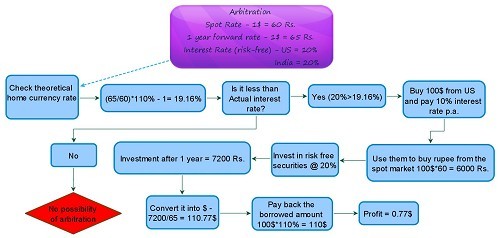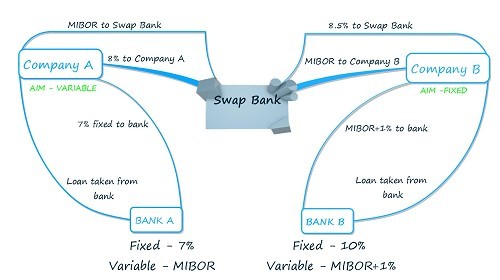Arbitration in Forex
Arbitration in forex is the possibility that the profit can be made out of exchange trading on the basis of forward rate and prevailing interest rate in 2 different countries.
Profit can only be made if returns made by borrowing from one country and depositing in other country fetches more return that keeping money for conversion at a later date at forward exchange rate. Let me show you this with the help of an example:

1. Suppose the exchange rate in the spot market is 1$ = Rs. 60 and after 1 year i.e. the forward rate would be 1$ = 65$. One can get 10% p.a. risk free return when one deposits funds in US while 20% p.a. when one deposits funds in India. Is there any possibility of arbitration? Let’s see.
2. First we have to check theoretical home currency rate. I have taken home currency INR i.e. Indian Rupee. What we have to do is to check how much times will the exchange rate change creating the possibility of arbitration.
For this, use following equation.

We have just checked that we are getting 19.16% which is less as compared to actual interest rate we can get by depositing funds in India. How to benefit from it?
Buy 100$ from US bank @ 10% p.a. (assuming that the interest on loan is same for the sake of simplicity) and invest it in the Indian bank by converting the US dollar received into Indian Rupee.
100$ in Rupee will be 6000 which will be invested in risk free securities @ 20%.
After 1 year one will receive 7200 Rs which will then be converted into US dollar at the prevailing rate at that time (which is the forward rate).
After conversion into US dollar one will get 110.77$ out of which 110$ will be used to pay back the US bank (interest included).
Profit will be 0.77$ or 50.05 Rs.
This is an example just to explain. Actual arbitration gain may be very high if exchange rates fluctuates less and if there is a difference between the risk free return. Suppose in the above example, forward rate is 1$ = 62 Rs. then a profit of 6.13$ per 100$ can be made by going through the same calculation.
Interest Rate Swaps – Interest Savings
Interest paid by a company on the basis of its preference can be minimized by following a procedure called swapping of interest rate involving a bank called swap bank. Basic concept is that the interest rate paid by a small company and a big company mismatches due to credit worthiness. As large companies borrow huge amounts, interest rates are low for them as compared to a small concern. The difference between the rates is where the swaps come into action.
Interest rates will always be high for a small concern than for a big concern. I will try to explain this simple concept with an example-

1. Company A is a large company whose aim is to take variable interest rate because its financial analysts think that variable rates will go down below 7%. The banker of company A is Bank A which is offering fixed rate @ 7% and variable rate @ MIBOR (Mumbai Inter-Bank Offer Rate).
2. Company B is a small concern whose aim is to take fixed interest rate because its financial analysts think that the fixed interest rate will save them from future uncertainties in the variable rate. The banker of company B is Bank B which is offering fixed rate @ 10% and variable rate @ MIBOR + 1%.
3. Both companies will approach swap bank to save some interest paid according to their respective preferences. It should be noted that these both companies don’t know each other. There are many companies who deal with swap bank, so the offers are matched and the deals are executed. I will first take Company A to explain the process.
4. Swap bank will advise Company A to take fixed interest rate loan from his banker @ 7%. Now swap bank agrees that it will give 8% interest rate to Company A and in return company A will give MIBOR to swap bank.
5. Total interest given by Company A = MIBOR to swap bank + 7% to bank A
Total interest received = 8% from swap bank
Effective interest rate given = MIBOR – 1%
Savings to company A over its preference = 1%
Similarly for Company B, swap bank advise it to take variable interest loan from his banker @ (MIBOR + 1%). Now swap bank agrees that it will give MIBOR to Company B and in return Company B will give 8.5% to swap bank.
Total interest given by Company B = (MIBOR + 1%) to bank B + 8.5% to swap bank
Total interest received = MIBOR
Effective interest rate = 9.5%
Savings to company B over its preference = 0.5%
Last question that comes to mind is what the benefit to swap bank is. Well, if you have noted that swap bank received MIBOR from Company A and 8.5% from Company B and gave 8% to Company A and MIBOR to Company B, the net difference is 0.5% which is the profit made by the swap bank.
These percentage may seem small but practically if the loan amount is just 10 Crores then savings would be:
Company A = 1%*10 Crores = 10 Lakhs
Company B = 0.5%*10 Crores = 5 Lakhs
Swap Bank = 0.5%*10 Crores = 5 Lakhs
The money is created due to the difference in the interest rates given by different banks to different companies.
Chiranjiv Kumar







 CAclubindia
CAclubindia

